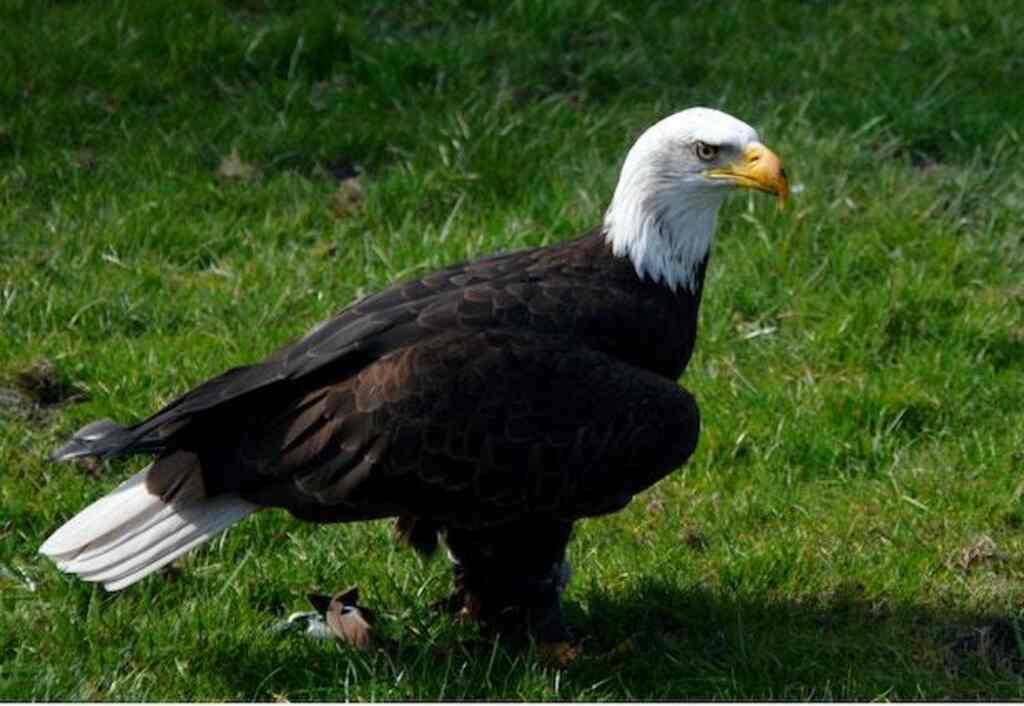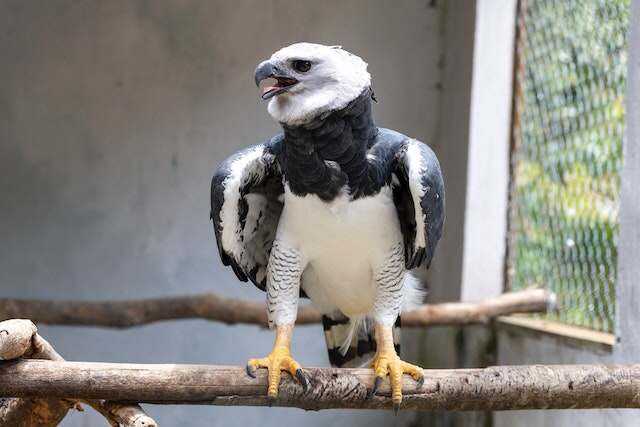Do Eagles Eat Rats? These majestic hunters of the avian realm have long fascinated us with their predatory prowess.
Join us as we delve into the captivating world of eagle diets, exploring the factors that shape their prey selection.
Discover the truth about their potential appetite for rats and unravel the intricate relationship between these regal birds and their curious culinary choices.
Table of Contents
- 1 Key Takeaways
- 2 Types of Prey Typically Consumed by Eagles
- 3 The Importance of a Varied Diet for Eagles
- 4 Common Prey Items for Eagles in the Wild
- 5 Do Eagles Eat Rats
- 6 The Role of Rats in the Diet of Eagles
- 7 Factors That Determine Eagle Prey Selection
- 8 Eagle Hunting Techniques and Strategies
- 9 Do Eagles Hunt Rats?
- 10 Instances of Eagles Eating Rats in the Wild
- 11 Potential Reasons Why Eagles May or May Not Eat Rats
- 12 The Impact of Rat Consumption on Eagle Populations
- 13 Conclusion: Understanding the Complex Feeding Habits of Eagles
- 14 Frequently Asked Questions
- 14.1 What are the different types of prey that eagles typically consume?
- 14.2 Why is it important for eagles to have a varied diet?
- 14.3 What are some common prey items for eagles in their natural habitat?
- 14.4 What is the role of rats in the diet of eagles?
- 14.5 What factors determine an eagle’s prey selection?
- 15 Author
Key Takeaways
- Eagles are opportunistic hunters and will consume rats when available.
- Rats can provide a valuable food source for eagles, especially in urban areas.
- Eagles require a varied diet to meet their nutritional needs and prevent deficiencies.
- Further research is needed to understand the implications of rat consumption for eagle populations.
Types of Prey Typically Consumed by Eagles
Eagles are known to consume a wide array of prey, including small mammals such as rats, which are often captured with precision and consumed with voracity.
The importance of a diverse diet for eagles cannot be overstated. Factors influencing prey selection include availability, abundance, and ease of capture.
Eagles are opportunistic hunters, adapting their diet to the resources found within their habitat.
While rats may not be the sole or preferred prey of eagles, they can be a valuable food source in certain circumstances.
Rats are abundant in many environments and provide a convenient and readily available food option for eagles.
However, it is important to note that eagles also consume a variety of other prey, such as fish, birds, and reptiles, to maintain a balanced diet.
The importance of a varied diet for eagles will be further explored in the subsequent section.
The Importance of a Varied Diet for Eagles
A diverse range of prey is crucial for maintaining optimal health and nutrition in the diet of these majestic birds of prey. Eagles require a variety of prey items to meet their nutritional needs.
By consuming a range of different species, eagles are able to obtain a balanced combination of proteins, fats, vitamins, and minerals.
This variety in diet helps to ensure that they receive all the necessary nutrients for their survival and overall well-being.
Additionally, a varied diet helps to prevent the risk of nutrient deficiencies or imbalances that could negatively impact the eagle’s health.
Therefore, it is essential for eagles to have access to a wide range of prey species in order to maintain their optimal health and thrive in their natural habitat.
Moving forward, we will explore the common prey items for eagles in the wild.
Common Prey Items for Eagles in the Wild
The diet of eagles in the wild consists of a wide range of prey items, including small mammals, birds, reptiles, and fish.
When it comes to small mammals, eagles have been known to prey on various types of rats. These include species such as the Norway rat, the roof rat, and the wood rat.
Eagles employ various hunting techniques to catch rats, such as soaring high in the sky and then diving to snatch their prey with their powerful talons.
They are also skilled at ambushing rats from perches or even catching them on the ground. Rats play an important role in the diet of eagles, providing them with a source of protein and nutrients.
Moving on to the subsequent section about the role of rats in the diet of eagles…
Do Eagles Eat Rats
Yes, eagles do eat rats. These majestic birds of prey have a diverse diet that includes small mammals like rats. They are skilled hunters, using their sharp vision and powerful talons to capture and consume their prey. Rats can be a part of their natural diet, but eagles also feed on a variety of other animals.
The Role of Rats in the Diet of Eagles
Rats are a significant dietary component for eagles, providing them with essential protein and nutrients. They play a crucial role in the diet of eagles, as they are a readily available and abundant source of prey.
Eagles are opportunistic hunters and have been observed to consume rats when other prey items are scarce or inaccessible.
The consumption of rats by eagles contributes to their overall nutritional requirements, particularly in terms of protein intake.
Rats are known to be rich in protein, which is essential for the growth, development, and maintenance of the eagle’s body.
Additionally, rats provide other important nutrients such as vitamins and minerals, further enhancing the nutritional value of their diet.
Incorporating a variety of prey items, including rats, allows eagles to maintain a balanced and diverse diet.
This adaptability in prey selection is one of the factors that determine the eagle’s survival in different habitats and environmental conditions.
Factors That Determine Eagle Prey Selection
One important aspect to consider when examining eagle prey selection is the influence of environmental factors. Factors affecting eagle prey selection include:
- Availability: Eagles are opportunistic hunters and will prey on the most abundant species in their habitat.
- Size and mobility: Eagles prefer prey that is of an appropriate size and can be easily captured and carried.
- Habitat: Eagles are adapted to specific habitats and will select prey that is most abundant and easily accessible in their environment.
- Competition: Eagles may choose prey that is less likely to attract competition from other predators.
Eagle prey preferences can vary depending on these factors, with some species of eagles showing a preference for fish, while others prefer small mammals or birds.
Understanding these factors is crucial in determining the dynamics of eagle prey selection.
In the subsequent section about eagle hunting techniques and strategies, we will explore how eagles utilize their physical characteristics and hunting behaviors to capture their prey.
Eagle Hunting Techniques and Strategies
Eagle hunting techniques and strategies involve a complex interplay of physical abilities, keen perception, and precise timing to effectively capture their prey.
Eagles have various hunting techniques that they employ depending on the situation and the type of prey they are targeting.
One common technique is known as the stoop, where the eagle dives from a great height to surprise and snatch its prey.
They also use soaring and gliding techniques to conserve energy while scanning the ground for potential prey.
In addition, eagles are known for their sharp eyesight, which allows them to spot prey from great distances.
They have the ability to adjust their flight patterns and position themselves strategically to maximize their chances of success.
These hunting strategies enable eagles to efficiently capture a wide range of prey, including small mammals like rats.
Transitioning to the subsequent section about whether eagles hunt rats, it is essential to understand how their hunting techniques and strategies contribute to their ability to catch such prey.
Do Eagles Hunt Rats?
Eagles are renowned for their exceptional hunting abilities, employing a diverse range of techniques to capture their prey.
While their preferred diet typically consists of small mammals, birds, and fish, there have been instances of eagles consuming rats.
These instances suggest that rats are not exempt from an eagle’s hunting repertoire.
The successful predation of rats by eagles can be attributed to their impressive hunting techniques, such as the aerial stoop, where the eagle dives rapidly from the sky to catch its prey.
Additionally, eagles possess sharp talons and a strong beak, which enable them to grasp and kill their prey efficiently.
Observations of eagles hunting rats in the wild provide valuable insights into their feeding habits and the adaptability of their hunting strategies.
These instances illuminate the dynamic nature of an eagle’s diet and its ability to exploit various food sources.
Instances of Eagles Eating Rats in the Wild
Instances of rats being included in the diet of eagles provides compelling evidence of the remarkable adaptability and versatility of these majestic birds of prey.
While eagles are known to primarily feed on fish and small mammals, including rabbits, squirrels, and rodents, the inclusion of rats in their diet highlights their ability to exploit a wide range of prey species.
This flexibility in diet is likely due to the eagle’s opportunistic feeding behavior, as they will take advantage of available food sources in their environment.
Additionally, the presence of rats in the eagle’s diet may also be influenced by rat population dynamics, as fluctuations in rodent populations can impact the availability of alternative prey.
Understanding the factors that influence eagle diet, such as rat population dynamics, is crucial for comprehending the ecological role of these magnificent birds.
Transitioning into the next section, potential reasons why eagles may or may not eat rats could shed further light on their dietary preferences.
Potential Reasons Why Eagles May or May Not Eat Rats
One possible determinant of the inclusion of rats in the diet of eagles is the availability and accessibility of other prey species in their habitat.
Factors affecting rat availability, such as competition with other predators or changes in the rat population, may influence whether eagles consume rats.
Additionally, the potential risks of rat consumption for eagles may also play a role. Rats can carry diseases, parasites, and toxins that could be harmful to eagles if ingested.
However, eagles have evolved powerful digestive systems that can handle a wide variety of prey, including rats.
Furthermore, rats are often abundant and easy to catch, making them a convenient food source for eagles. These factors may contribute to the occasional inclusion of rats in an eagle’s diet.
The impact of rat consumption on eagle populations will be discussed in the subsequent section, exploring the potential consequences of this dietary choice.
The Impact of Rat Consumption on Eagle Populations
The previous subtopic explored potential reasons why eagles may or may not eat rats. Now, let us delve into the ecological impact of rat consumption on eagle populations and the potential risks associated with it.
While eagles are known to be opportunistic predators and have been observed feeding on rats in certain circumstances, the extent of rat consumption and its consequences on eagle populations are not well understood.
Rats are known carriers of diseases such as leptospirosis and toxoplasmosis, which can be detrimental to bird species.
Additionally, rats are known to compete with eagles for food resources, potentially leading to a decrease in prey availability.
Further research is needed to fully comprehend the implications of rat consumption for eagle populations and to identify potential management strategies.
Understanding the complex feeding habits of eagles is crucial for their conservation and the maintenance of healthy ecosystems.
Transitioning into the subsequent section, let us now explore the conclusion: understanding the complex feeding habits of eagles.
Conclusion: Understanding the Complex Feeding Habits of Eagles
Understanding the intricate feeding patterns of eagles is essential for comprehending their ecological role and promoting the preservation of diverse ecosystems.
Eagles exhibit a diverse range of dietary preferences, with some species being more specialized in their food choices than others.
Rat consumption by eagles is not uncommon and can vary depending on the availability of other prey species.
- Eagles are opportunistic predators and will consume rats when they are readily available.
- Rats can provide a valuable food source for eagles, especially in urban areas where they may be abundant.
- However, eagles also rely on a variety of other prey items such as fish, small mammals, birds, and carrion.
- The consumption of rats by eagles does not pose a significant threat to rat populations, as eagles are not their primary predator.
Overall, understanding the complex feeding habits of eagles is crucial for managing and conserving their populations and the ecosystems they inhabit.
Further research is needed to gain a more comprehensive understanding of the factors influencing eagle dietary preferences and the ecological implications of rat consumption.
Frequently Asked Questions
What are the different types of prey that eagles typically consume?
Eagles have a varied diet, consuming a range of prey items such as fish, small mammals, birds, and reptiles. A diverse diet is crucial for eagles as it provides essential nutrients and helps maintain their population by reducing competition and ensuring a sustainable food source.
Why is it important for eagles to have a varied diet?
The importance of a varied diet in eagles lies in its impact on their overall health and survival. A diverse diet ensures access to essential nutrients, reduces the risk of nutrient deficiencies, and increases adaptability to changes in prey availability.
What are some common prey items for eagles in their natural habitat?
Common prey items for eagles in their natural habitat include small mammals such as rodents, rabbits, and squirrels, as well as birds, fish, and reptiles. Eagle hunting techniques and the nutritional benefits of different prey items contribute to their varied diet.
What is the role of rats in the diet of eagles?
The role of rats in the eagle diet is significant, as they serve as a common prey item. Rat consumption can impact eagle health positively, providing essential nutrients and contributing to their overall diet diversity.
What factors determine an eagle’s prey selection?
Factors that determine an eagle’s prey selection include availability, abundance, vulnerability, and energy gain. Predation is influenced by the eagle’s foraging behavior, hunting skills, and the ecological interactions within its habitat.






